2018 MITSUBISHI OUTLANDER III ECO mode
[x] Cancel search: ECO modePage 364 of 441
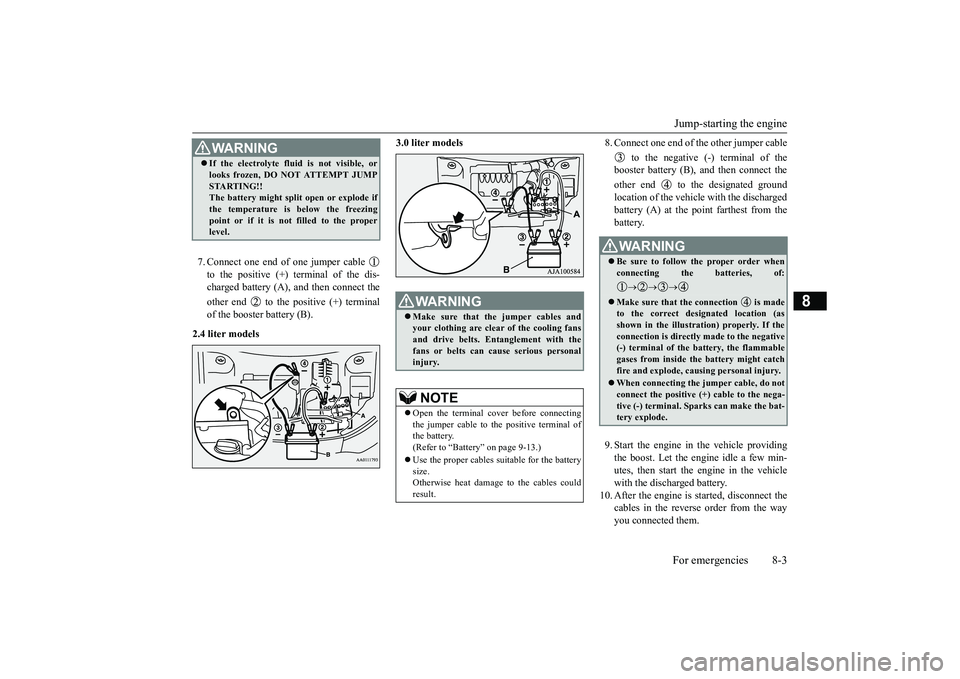
Jump-starting the engineFor emergencies 8-3
8
7. Connect one end of one jumper cable to the positive (+) terminal of the dis-charged battery (A),
and then connect the
other end to the positive (+) terminalof the booster battery (B).
2.4 liter models
3.0 liter models
8. Connect one end of the other jumper cable
to the negative (-) terminal of thebooster battery (B), a
nd then connect the
other end to the designated groundlocation of the vehicl
e with the discharged
battery (A) at the point farthest from thebattery.9. Start the engine in the vehicle providingthe boost. Let the engine idle a few min-utes, then start the engine in the vehiclewith the discharged battery.
10. After the engine is
started, disconnect the
cables in the reverse order from the wayyou connected them.
WA R N I N GIf the electrolyte flui
d is not visible, or
looks frozen, DO NOT ATTEMPT JUMPSTARTING!!The battery might split open or explode ifthe temperature is below the freezingpoint or if it is not filled to the properlevel.
WA R N I N GMake sure that the jumper cables andyour clothing are clear of the cooling fansand drive belts. Entanglement with thefans or belts can ca
use serious personal
injury.NOTE
Open the terminal cover before connectingthe jumper cable to the positive terminal ofthe battery.(Refer to “Battery” on page 9-13.)Use the proper cables suitable for the batterysize.Otherwise heat damage
to the cables could
result.
WA R N I N GBe sure to follow the proper order whenconnecting the batteries, of:
Make sure that the connection is madeto the correct designated location (asshown in the illustration) properly. If theconnection is directly made to the negative(-) terminal of the battery, the flammablegases from inside the battery might catchfire and explode, caus
ing personal injury.
When connecting the jumper cable, do notconnect the positive (+) cable to the nega-tive (-) terminal. Sparks can make the bat-tery explode.
BK0249100US.book 3 ページ 2017年5月10日 水曜日 午前8時49分
Page 383 of 441
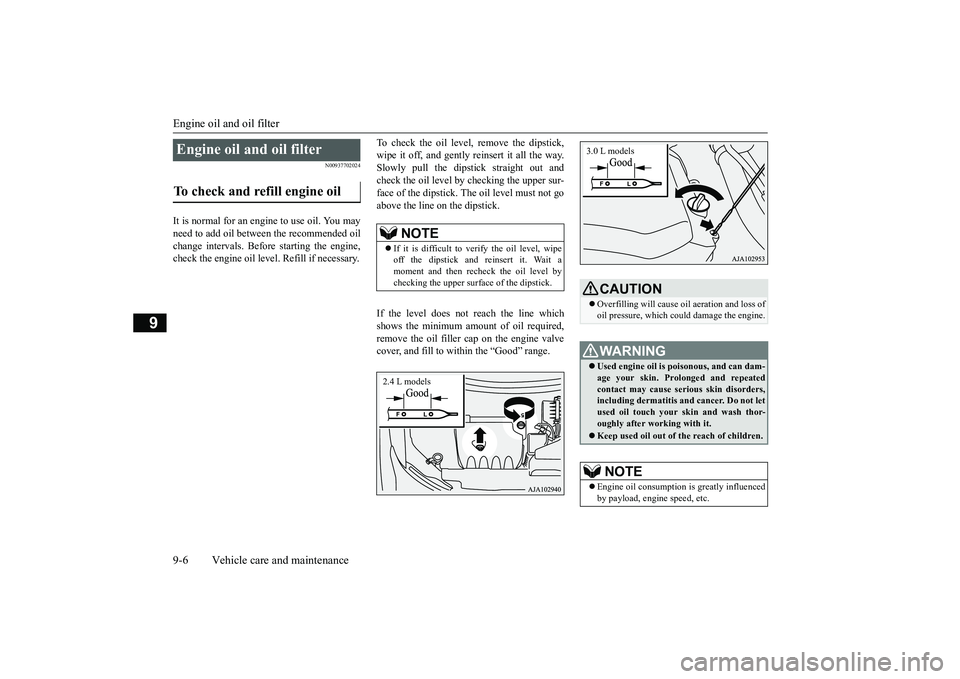
Engine oil and oil filter9-6 Vehicle care and maintenance
9
N00937702024
It is normal for an engi
ne to use oil. You may
need to add oil between the recommended oilchange intervals. Befo
re starting the engine,
check the engine oil leve
l. Refill if necessary.
To check the oil level, remove the dipstick,wipe it off, and gently
reinsert it all the way.
Slowly pull the dipsti
ck straight out and
check the oil level by checking the upper sur-face of the dipstick. Th
e oil level must not go
above the line on the dipstick.If the level does not reach the line whichshows the minimum amo
unt of oil required,
remove the oil filler cap on the engine valvecover, and fill to within the “Good” range.
Engine oil and oil filter To check and refill engine oil
NOTE
If it is difficult to verify the oil level, wipeoff the dipstick and
reinsert it. Wait a
moment and then recheck the oil level bychecking the upper surfa
ce of the dipstick.
2.4 L models
CAUTIONOverfilling will cause
oil aeration and loss of
oil pressure, which coul
d damage the engine.
WA R N I N GUsed engine oil is po
isonous, and can dam-
age your skin. Prolonged and repeatedcontact may cause serious skin disorders,including dermatitis and cancer. Do not letused oil touch your sk
in and wash thor-
oughly after working with it.Keep used oil out of
the reach of children.
NOTE
Engine oil consumption
is greatly influenced
by payload, engine speed, etc.3.0 L models
BK0249100US.book 6 ページ 2017年5月10日 水曜日 午前8時49分
Page 387 of 441

Air cleaner filter9-10 Vehicle care and maintenance
9
3. Unclamp the cover. Open up the top of thecover and take out th
e air cleaner filter.
4. Replace the air cleane
r filter and put the
cover back on in its original position.
5. For 2.4 L models, put the duct back on inits original position.
2.4 L models
NOTE
Mitsubishi Motors Genuine Parts are recom-mended when replacing th
e air cleaner filter.
For 2.4 L models, make
sure that the connec-
tor is properly reconnected.After replacing the air cleaner filter, makesure that the hinges at the bottom of coverare firmly set.3.0 L models
CAUTIONTake care not to scra
tch the engine air flow
sensor when removing
the air cleaner cover.
2.4 L models3.0 L models
BK0249100US.book 10 ページ 2017年5月10日 水曜日 午前8時49分
Page 389 of 441
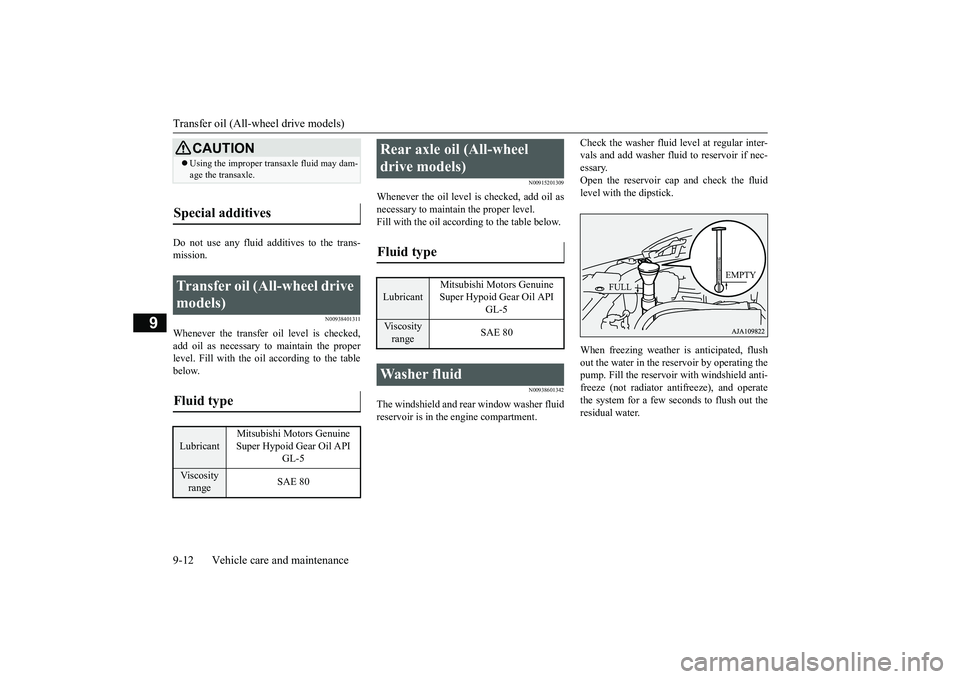
Transfer oil (All-w
heel drive models)
9-12 Vehicle care and maintenance
9
Do not use any fluid additives to the trans-mission.
N00938401311
Whenever the transfer oil level is checked,add oil as necessary to maintain the properlevel. Fill with the oil according to the tablebelow.
N00915201309
Whenever the oil level is checked, add oil asnecessary to maintain the proper level.Fill with the oil according to the table below.
N00938601342
The windshield and rear window washer fluidreservoir is in the
engine compartment.
Check the washer fluid
level at regular inter-
vals and add washer fluid to reservoir if nec-essary.Open the reservoir cap and check the fluidlevel with the dipstick.When freezing weather is anticipated, flushout the water in the reservoir by operating thepump. Fill the reservoi
r with windshield anti-
freeze (not radiator an
tifreeze), and operate
the system for a few seconds to flush out theresidual water.
CAUTIONUsing the improper transaxle fluid may dam-age the transaxle.
Special additives
Transfer oil (All-wheel drive models) Fluid type Lubricant
Mitsubishi Motors Genuine Super Hypoid Gear Oil API
GL-5
Viscosity range
SAE 80
Rear axle oil (All-wheel drive models) Fluid type Lubricant
Mitsubishi Motors Genuine Super Hypoid Gear Oil API
GL-5
Viscosity range
SAE 80
Washer fluid
FULL
EMPTY
BK0249100US.book 12 ページ 2017年5月10日 水曜日 午前8時49分
Page 392 of 441

Tires
Vehicle care and maintenance 9-15
9
N00939201651
It is important to familiarize yourself with thefollowing terms:Cold tire pressure:• The measured pressure after the vehiclehas been parked for
at least three hours,
or• The measured pressure when the vehicleis driven less than 1 mile (1.6 km) afterhaving been parked for three hours.
Maximum pressure: the maximum per-missible cold tire inflation pressure forthis tire.Recommended inflation pressure: theinflation pressure for optimum tire perfor-mance.Intended outboard sidewall:• The sidewall that
contains a whitewall,
bears white lettering or bears manufac-turer, brand, and/or model name moldingthat is higher or deeper than the samemolding on the other sidewall of the tire,or
• The outward facing si
dewall of an asym-
metrical tire that has a particular sidethat must always face outward whenmounted on a vehicle.
Passenger car tire: a
tire intended for use
on passenger cars, multipurpose passen-ger vehicles, and trucks
that have a gross
vehicle weight rati
ng (GVWR) of 10,000
pounds or less.Light truck (LT) tire: a tire designated byits manufacturer as primarily intended foruse on lightweight truc
ks or multipurpose
passenger vehicles.Tread: portion of a ti
re that comes into
contact with the road.Tread rib: a tread se
ction running circum-
ferentially around a tire.Tread separation: pulling away of thetread from the tire carcass.Carcass: the tire structure, except treadand sidewall rubber wh
ich, when inflated,
bears the load.Sidewall: portion of
a tire between the
tread and bead.Section width: the lin
ear distance between
the exteriors of th
e sidewalls of an
inflated tire, excluding elevations due tolabeling, decoration,
or protective bands.
Bead: the part of the tire that is made ofsteel wires, wrapped or reinforced by plycords and that is shaped to fit the rim.
NOTE
Check each battery terminal for corrosion.You can prevent further corrosion by wash-ing with a solution of
baking soda and water.
Grease the posts and cl
amps after cleaning or
tightening them.Ensure the battery is securely installed andcannot be moved. Also
check each terminal
for tightness.If you will not be driv
ing your vehicle for a
long period of time, re
move the battery and
store it in a place where the battery fluid willnot freeze. The batter
y only should be stored
with a full charge.Before cleaning the battery, tighten all thefiller port caps to keep
dirt and moisture out.
Tires
WA R N I N GDriving with tires that are worn, damagedor improperly infl
ated is dangerous.
These type tire conditions will adverselyaffect vehicle performance.These type tire conditions can also cause atread separation or blowout which mayresult in an accident causing seriousinjury or death.
Tires, including spar
e tire, degrade over
time with age even when they are notbeing used.It is recommended that tires over 6 yearsgenerally be replaced
even if damage is
not obvious.WA R N I N G
BK0249100US.book 15 ページ 2017年5月10日 水曜日 午前8時49分
Page 407 of 441
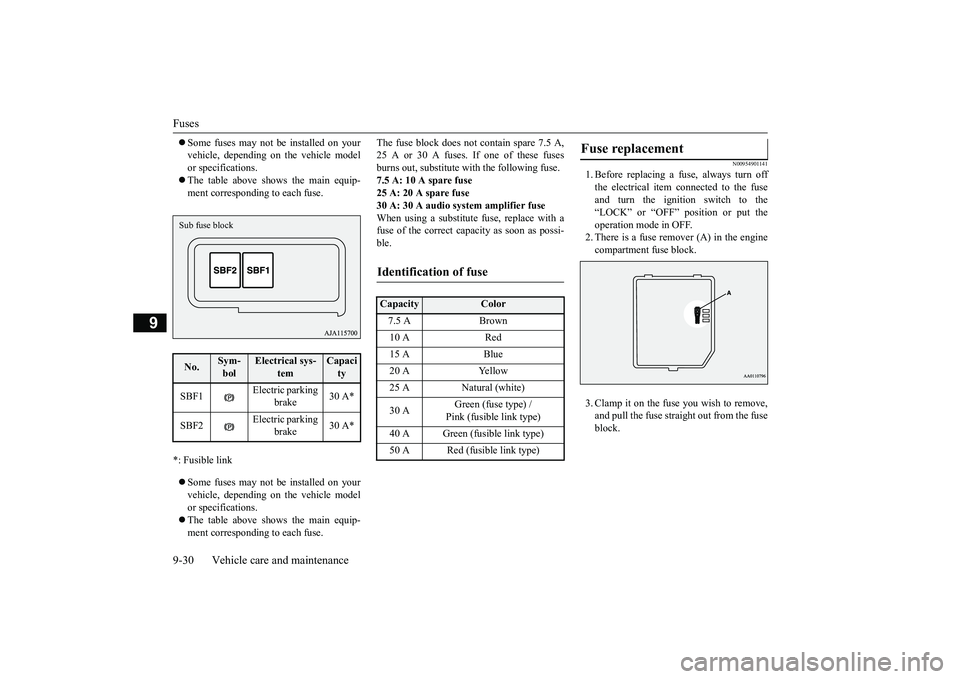
Fuses9-30 Vehicle care and maintenance
9
Some fuses may not be installed on yourvehicle, depending on the vehicle modelor specifications.The table above shows the main equip-ment corresponding to each fuse.
*: Fusible linkSome fuses may not be installed on yourvehicle, depending on the vehicle modelor specifications.The table above shows the main equip-ment corresponding to each fuse.
The fuse block does not contain spare 7.5 A,25 A or 30 A fuses. If one of these fusesburns out, substitute w
ith the following fuse.
7.5 A: 10 A spare fuse25 A: 20 A spare fuse30 A: 30 A audio system amplifier fuseWhen using a substitute
fuse, replace with a
fuse of the correct capa
city as soon as possi-
ble.
N00954901141
1. Before replacing a fuse, always turn offthe electrical item
connected to the fuse
and turn the ignition switch to the“LOCK” or “OFF” position or put theoperation mode in OFF.2. There is a fuse remover (A) in the enginecompartment fuse block.3. Clamp it on the fuse you wish to remove,and pull the fuse straight out from the fuseblock.
No.
Sym-bol
Electrical sys-
tem
Capacity
SBF1
Electric parking
brake
30 A*
SBF2
Electric parking
brake
30 A*
Sub fuse block
Identification of fuse Capacity
Color
7.5 A Brown10 A Red15 A Blue20 A Yellow25 A Natural (white)30 A
Green (fuse type) /Pink (fusible link type)
40 A Green (fusible link type)50 A Red (fusible link type)
Fuse replacement
BK0249100US.book 30 ページ 2017年5月10日 水曜日 午前8時49分
Page 436 of 441

Alphabetical index
12-1
12
Numerics
12 V power outlets
............................
5-230
4-wheel drive operation
.......................
5-88
A
Accessory (installation)
.........................
3-6
Active stability control (ASC)
............
5-100
Adaptive Cruise C
ontrol System (ACC)
.......
5-107Air cleaner filter
...................................
9-9
Air conditioner
Dual-zone automatic climate control airconditioner
.....................................
7-5
Important air condi
tioning operating tips
..
7-13
Air purifier
.........................................
7-14
Airbag
...............................................
4-35
All-wheel drive operation
....................
5-88
Aluminum wheels
...............................
9-43
Anti-lock braking system
.....................
5-97
Arm rest
.............................................
4-10
Assist grip
........................................
5-246
Automatic high beam system
.............
5-211
Automatic transaxle
............................
5-68
Fluid
.....................................
9-11
, 11-7
Selector lever operation
...................
5-68
Selector lever positions
...................
5-71
Sports mode
...................................
5-72
B
Back-up light
Bulb capacity
.................................
9-32
Replacement
..................................
9-38
Ball joint, steering linka
ge seals, drive shaft
boots
...............................................
9-24
Battery
..............................................
9-13
Charging system warning light
.......
5-204
Checking battery
electrolyte level
....
9-13
Disconnection and connection
.........
9-14
During cold weather
.......................
9-14
Specification
..................................
11-6
Blind Spot Warning (BSW)
................
5-126
Bottle holders
....................................
5-243
Brake
Fluid
.....................................
9-13
, 11-7
Brake assist
........................................
5-96
Braking
Anti-lock braking system
................
5-97
Braking
...........................................
6-5
Hose
.............................................
9-24
Pad wear alarm
..............................
5-93
Parking brake
.................................
5-53
Pedal
.............................................
5-92
Pedal free play
...............................
9-22
Power brakes
.................................
5-92
Service brake
.................................
5-92
Warning lights and buzzer
.............
5-203
Break-in recommendations
....................
5-3
Bulb capacity
......................................
9-32
C
California Perchl
orate Materials
Requirements
.....................................
3-7
Capacities
..........................................
11-7
Card holder
............................
5-229
, 5-240
Cargo area cover
...............................
5-244
Cargo loads
........................................
6-10
Cargo room light
...............................
5-238
Bulb capacity
.................................
9-33
Catalytic converter
................................
9-2
Cautions on the handling of all-wheel drive vehicles
............................................
5-91
Certification label
...............................
11-3
Charging system warning light
...........
5-204
Child restraint systems
........................
4-27
Child safety locks for rear door
............
5-37
Cleaning
Inside of your vehicle
......................
9-40
Outside of your vehicle
...................
9-41
Coat hook
.........................................
5-246
Consumer information
.........................
10-2
Continuously variable transmission (CVT)
...
5-75
BK0249100US.book 1 ページ 2017年5月10日 水曜日 午前8時49分
Page 437 of 441
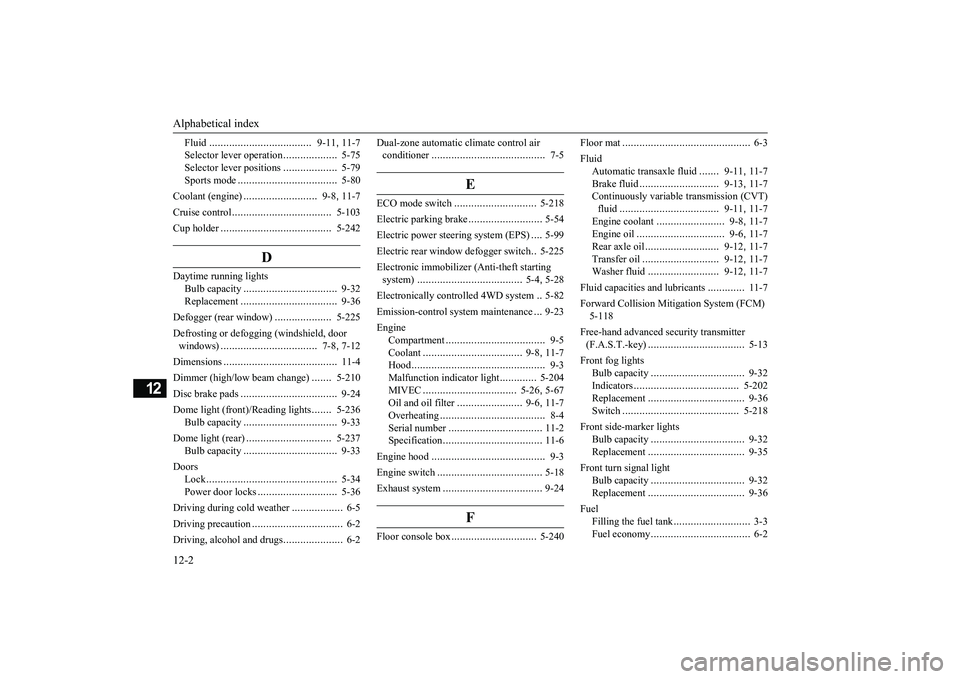
Alphabetical index12-2
12
Fluid
....................................
9-11
, 11-7
Selector lever operation
...................
5-75
Selector le
ver positions
...................
5-79
Sports mode
...................................
5-80
Coolant (engine)
..........................
9-8
, 11-7
Cruise control
...................................
5-103
Cup holder
.......................................
5-242
D
Daytime running lights
Bulb capacity
.................................
9-32
Replacement
..................................
9-36
Defogger (rear window)
....................
5-225
Defrosting or defogging (windshield, door windows)
..................................
7-8
, 7-12
Dimensions
........................................
11-4
Dimmer (high/lo
w beam change)
.......
5-210
Disc brake pads
..................................
9-24
Dome light (front)/Reading lights
.......
5-236
Bulb capacity
.................................
9-33
Dome light (rear)
..............................
5-237
Bulb capacity
.................................
9-33
Doors
Lock
..............................................
5-34
Power door locks
............................
5-36
Driving during cold weather
..................
6-5
Driving precaution
................................
6-2
Driving, alcohol and drugs
.....................
6-2
Dual-zone automatic climate control air conditioner
........................................
7-5
E
ECO mode switch
.............................
5-218
Electric parking brake
..........................
5-54
Electric power steering system (EPS)
....
5-99
Electric rear window
defogger switch
..5-225
Electronic immobilizer (Anti-theft starting system)
.....................................
5-4
, 5-28
Electronically cont
rolled 4WD system
..5-82
Emission-control system maintenance
...
9-23
Engine
Compartment
...................................
9-5
Coolant
...................................
9-8
, 11-7
Hood
...............................................
9-3
Malfunction indicator light
.............
5-204
MIVEC
.................................
5-26
, 5-67
Oil and oil filter
.......................
9-6
, 11-7
Overheating
.....................................
8-4
Serial number
.................................
11-2
Specification
...................................
11-6
Engine hood
........................................
9-3
Engine switch
.....................................
5-18
Exhaust system
...................................
9-24
F
Floor console box
..............................
5-240
Floor mat
.............................................
6-3
Fluid
Automatic transaxle fluid
.......
9-11
, 11-7
Brake fluid
............................
9-13
, 11-7
Continuously variable transmission (CVT)fluid
...................................
9-11
, 11-7
Engine coolant
........................
9-8
, 11-7
Engine oil
...............................
9-6
, 11-7
Rear axle oil
..........................
9-12
, 11-7
Transfer oil
...........................
9-12
, 11-7
Washer fluid
.........................
9-12
, 11-7
Fluid capacities and lubricants
.............
11-7
Forward Collision Miti
gation System (FCM)
5-118Free-hand advanced security transmitter (F.A.S.T.-key)
..................................
5-13
Front fog lights
Bulb capacity
.................................
9-32
Indicators
.....................................
5-202
Replacement
..................................
9-36
Switch
.........................................
5-218
Front side-marker lights
Bulb capacity
.................................
9-32
Replacement
..................................
9-35
Front turn signal light
Bulb capacity
.................................
9-32
Replacement
..................................
9-36
Fuel
Filling the fuel tank
...........................
3-3
Fuel economy
...................................
6-2
BK0249100US.book 2 ページ 2017年5月10日 水曜日 午前8時49分